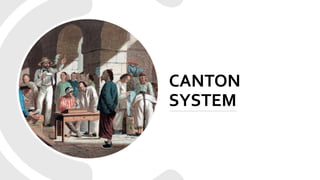
Canton Trade System in China
- 2. 2 The Canton System was a trade policy imposed by the Qing Dynasty in China from the 17th to the 19th century. It aimed to regulate and control foreign trade, particularly with European merchants. (Canton)
- 3. 3 The major characteristics of the system developed between 1760 and 1842, when all foreign trade coming into China was confined to Canton and the foreign traders entering the city were subject to a series of regulations by the Chinese government.
- 4. 4 Limited Trade Closed Door Policy Monopoly of the Cohong Trade Regulations Fixed Prices Limited Goods Payment in Silver Control and Surveillance
- 5. 5 Limited Trade Closed Door Policy Monopoly of the Cohong Trade Regulations Fixed Prices Limited Goods Payment in Silver Control and Surveillance Under the Canton System, foreign trade was restricted to the port of Canton in southern China. European traders, primarily from Britain, were only allowed to conduct business through a designated group of licensed Chinese merchants known as the Cohong.
- 6. 6 Limited Trade Closed Door Policy Monopoly of the Cohong Trade Regulations Fixed Prices Limited Goods Payment in Silver Control and Surveillance Foreign merchants involved in Canton trade were prohibited from learning Chinese language and customs. They were obliged to obey Chinese criminal and commercial laws in Canton. The entry of women and firearms into foreign trading posts, the employment of female slaves etc. were prohibited. At the end of the trading season, foreign merchants who came to Canton had to leave this port.
- 7. 7 Limited Trade Closed Door Policy Monopoly of the Cohong Trade Regulations Fixed Prices Limited Goods Payment in Silver Control and Surveillance The Cohong was a select group of Chinese merchants authorized by the government to handle foreign trade. They enjoyed a monopoly on all trade activities, including purchasing, selling, and exporting goods. European traders were required to deal exclusively with the Cohong.
- 8. 8 Limited Trade Closed Door Policy Monopoly of the Cohong Trade Regulations Fixed Prices Limited Goods Payment in Silver Control and Surveillance Strict regulations were imposed on foreign traders. They were only permitted to trade during the Canton Trade Fair, which occurred once a year. European traders had to live in the foreign factories (isolated areas) and were not allowed to venture into other parts of the country.
- 9. 9 Limited Trade Closed Door Policy Monopoly of the Cohong Trade Regulations Fixed Prices Limited Goods Payment in Silver Control and Surveillance The Canton System established fixed prices for goods, determined by the Chinese authorities. This limited the bargaining power of foreign traders and ensured a favorable balance of trade for China. It also prevented direct contact between European traders and Chinese producers.
- 10. 10 Limited Trade Closed Door Policy Monopoly of the Cohong Trade Regulations Fixed Prices Limited Goods Payment in Silver Control and Surveillance The system permitted the trade of a select range of goods, primarily luxury items such as tea, silk, porcelain, and spices. Chinese authorities strictly prohibited the export of certain commodities, including opium.
- 11. 11 Limited Trade Closed Door Policy Monopoly of the Cohong Trade Regulations Fixed Prices Limited Goods Payment in Silver Control and Surveillance European merchants were required to pay for their purchases in silver. This led to a significant outflow of silver from Europe to China, as the Qing Dynasty only accepted silver as a form of payment, further exacerbating trade imbalances.
- 12. 12 Limited Trade Closed Door Policy Monopoly of the Cohong Trade Regulations Fixed Prices Limited Goods Payment in Silver Control and Surveillance Chinese officials closely monitored foreign traders and their activities. They enforced strict laws to prevent smuggling and unauthorized trade. Foreign ships were subject to extensive inspections, and severe penalties were imposed for any violations.
- 13. 13 Over time, the Canton System faced growing criticism and resentment from European traders who sought more favorable trade conditions. The system was progressively weakened, and eventually abolished in 1842 following the First Opium War, which resulted in the Treaty of Nanjing. Decline and Abolition
- 14. THANKYOU!